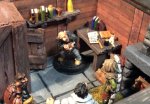Doctor Futurity
Hero
I have three games going, one with 14 sessions in (hitting level 6 now), one with about 8 sessions in (hitting level 4 in that group) and a third group playing starting at level 12 and about 3 sessions in (no advancement yet). My top five takes so far as the GM:
1. CR -4/+4 to party level is significant. A Level 3 party against a CR 8 foe is a TPK waiting to happen. In the levl 12 case, opponents of CR 7 or less are probably best resolved as an out-of-encounter event or just describe it as "And then you kicked their asses." For opponents of too high a level, best to give them fair warning through some lore checks that they may be over their heads in deep trouble.
2. The fumble/crit range of 10 higher or lower is an amazing mechanic but can be brutal on the PCs. If you use the crit and fumble decks, agree on the way you apply them, and consider the consequences of the more lethal applications when designing encounters.
3. The game favors downtime when possible. Players may not catch on, or may not realize they need to seek downtime occasionally. Bake options for downtime into your scenario/plot so they can recover and craft and stuff.
4. I have been following the cash/gear reward rules as rigorously as possible. It works well but seems to distribute less loot than they are used to from other experiences. I am fine with this, but just be aware it may be a thing. Be a tiny bit more liberal in handing out the consumable items at low levels, it will offset the sting a bit.
5. As GM, pay close attention to the skill feats so you don't get tripped up on who can do what in play. Read the skill rules; they are precise in how they apply, and some function in ways that they didn't used to having absorbed certain skills (for example, linguistics is folded in to society). Don't be afraid to let PCs use skill checks in odd ways....just be aware when they ask for an effect that is "good enough" to qualify for a skill feat instead. A basic example that will trip you up: searching for tracks is a skill check; identifying the types and natures of the animals that made the tracks requires a skill feat, however.
1. CR -4/+4 to party level is significant. A Level 3 party against a CR 8 foe is a TPK waiting to happen. In the levl 12 case, opponents of CR 7 or less are probably best resolved as an out-of-encounter event or just describe it as "And then you kicked their asses." For opponents of too high a level, best to give them fair warning through some lore checks that they may be over their heads in deep trouble.
2. The fumble/crit range of 10 higher or lower is an amazing mechanic but can be brutal on the PCs. If you use the crit and fumble decks, agree on the way you apply them, and consider the consequences of the more lethal applications when designing encounters.
3. The game favors downtime when possible. Players may not catch on, or may not realize they need to seek downtime occasionally. Bake options for downtime into your scenario/plot so they can recover and craft and stuff.
4. I have been following the cash/gear reward rules as rigorously as possible. It works well but seems to distribute less loot than they are used to from other experiences. I am fine with this, but just be aware it may be a thing. Be a tiny bit more liberal in handing out the consumable items at low levels, it will offset the sting a bit.
5. As GM, pay close attention to the skill feats so you don't get tripped up on who can do what in play. Read the skill rules; they are precise in how they apply, and some function in ways that they didn't used to having absorbed certain skills (for example, linguistics is folded in to society). Don't be afraid to let PCs use skill checks in odd ways....just be aware when they ask for an effect that is "good enough" to qualify for a skill feat instead. A basic example that will trip you up: searching for tracks is a skill check; identifying the types and natures of the animals that made the tracks requires a skill feat, however.



